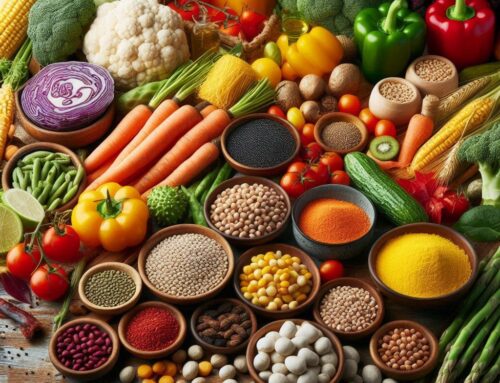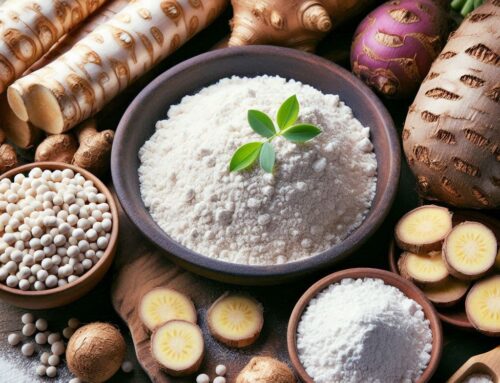
Understanding Konjac: What is It and How is it Used?
Konjac, a plant native to Southeast Asia, has gained popularity worldwide due to its unique properties and versatile applications. At the heart of this plant is the konjac root, which is rich in glucomannan—a dietary fiber known for its remarkable ability to absorb water and expand. This characteristic makes it an excellent ingredient for various culinary and health-related uses.
The konjac plant’s most notable component, glucomannan, is often utilized as a dietary supplement for weight management due to its ability to promote a feeling of fullness. Additionally, it’s commonly found in food products like shirataki noodles and rice alternatives, offering low-calorie options for those looking to reduce their carbohydrate intake without sacrificing satisfaction.
Beyond the kitchen, konjac has several other applications. Its high fiber content supports digestive health and can aid in regulating blood sugar levels. In the beauty industry, konjac sponges have become popular for their gentle exfoliating properties and ability to cleanse skin without irritation.
Overall, the diverse uses of konjac make it a valuable addition across multiple sectors—from nutrition and wellness to skincare—demonstrating its wide-ranging benefits derived from both traditional practices and modern innovations.
The Nutritional Profile of Konjac: Why It’s Considered a Superfood
Konjac, often hailed as a superfood, boasts an impressive nutritional profile that makes it a popular choice for health-conscious individuals. At the heart of konjac’s appeal is its high content of dietary fiber, specifically glucomannan, which is known for promoting digestive health and aiding in weight management. This soluble fiber expands in the stomach, creating a feeling of fullness and helping to reduce overall calorie intake.
In addition to its fiber content, konjac is celebrated as a low-calorie food. It provides minimal calories while delivering essential plant-based nutrients, making it an ideal option for those looking to maintain or lose weight without sacrificing nutritional value. The plant-based nature of konjac also means it fits well into vegetarian and vegan diets.
Beyond its benefits for digestion and weight control, konjac may also help regulate blood sugar levels due to its ability to slow down carbohydrate absorption. This makes it an excellent choice for individuals managing diabetes or those seeking stable energy levels throughout the day.
Overall, the nutritional profile of konjac offers numerous health benefits that contribute to its status as a superfood. Its combination of dietary fiber and low-calorie content supports various aspects of well-being while fitting seamlessly into diverse dietary preferences.
Konjac and Blood Sugar Levels: Can It Aid in Managing Diabetes?
Konjac, a root vegetable native to Asia, has been gaining attention for its potential benefits in managing diabetes and controlling blood sugar levels. This plant is rich in glucomannan, a soluble fiber known for its ability to slow down the digestion process and reduce the absorption of carbohydrates. As a result, it can help maintain stable glucose levels by preventing sharp spikes after meals.
One of the primary reasons konjac is considered beneficial for people with diabetes is its low glycemic index (GI). Foods with a low GI are digested more slowly, leading to gradual increases in blood sugar rather than sudden surges. By incorporating konjac into their diets, individuals may experience improved blood sugar control and better overall diabetes management.
Studies have shown that consuming konjac can contribute to lower fasting glucose levels and improved insulin sensitivity. Additionally, its high fiber content promotes satiety, which can aid in weight management—a crucial aspect of controlling diabetes.
Incorporating konjac into your diet could be as simple as adding konjac noodles or flour to meals. However, it’s important to consult with healthcare professionals before making significant dietary changes, especially for those managing chronic conditions like diabetes. Overall, while more research is needed to fully understand all the effects of konjac on blood sugar control, it represents a promising addition to a balanced diet aimed at managing glucose levels effectively.
The Role of Glucomannan in Reducing Cholesterol and Aiding Weight Loss
Glucomannan, a natural dietary fiber derived from the root of the konjac plant, has gained attention for its potential health benefits, particularly in cholesterol reduction and weight management. As an effective water-soluble fiber, glucomannan works by absorbing water in the digestive tract, forming a bulky fiber that aids in creating a feeling of fullness. This characteristic makes it one of the promising weight management aids available today.
One of the key glucomannan benefits is its ability to support healthy cholesterol levels. Research suggests that glucomannan can help lower LDL cholesterol—the “bad” cholesterol—by binding to bile acids in the gut and promoting their excretion from the body. This process forces the liver to convert more cholesterol into bile acids, thereby reducing overall blood cholesterol levels.
In terms of weight management, glucomannan’s role is primarily attributed to its capacity to expand in the stomach upon absorbing water. This expansion leads to increased satiety with fewer calories consumed, making it easier for individuals to adhere to calorie-restricted diets without experiencing excessive hunger. Additionally, as a fiber-rich supplement, glucomannan can help regulate bowel movements and improve gut health.
While incorporating glucomannan into one’s diet may provide these benefits, it’s important for individuals considering this supplement to consult with healthcare professionals. Proper dosage and timing are crucial for maximizing its efficacy while minimizing potential side effects such as gastrointestinal discomfort. Overall, when used appropriately alongside a balanced diet and regular exercise routine, glucomannan can be an effective component of strategies aimed at reducing cholesterol and supporting weight loss efforts.
Potential Side Effects of Consuming Konjac: What You Need to Know
Konjac, a root vegetable native to parts of Asia, has gained popularity as a dietary supplement and food product due to its high fiber content and potential health benefits. However, like any supplement or dietary change, it is important to be aware of the potential side effects associated with its consumption.
One of the most commonly reported konjac side effects is digestive discomfort. Due to its high glucomannan fiber content, konjac can cause bloating, gas, and diarrhea in some individuals. These digestive issues with konjac are particularly prevalent when consumed in large quantities or by those who are not accustomed to a high-fiber diet. To minimize these effects, it is recommended to gradually introduce konjac into your diet and ensure adequate water intake.
Safety concerns for diabetics also arise when consuming konjac products. While glucomannan can help regulate blood sugar levels by slowing carbohydrate absorption, it’s crucial for individuals with diabetes to monitor their blood glucose closely when incorporating konjac into their diet. As always, consulting with a healthcare professional before making significant dietary changes is advisable.
In summary, while konjac offers various health benefits such as weight management and improved digestion for many people, being informed about potential side effects ensures that you can enjoy its advantages safely and effectively.
How to Incorporate Konjac into Your Diet Safely and Effectively
Incorporating konjac into your diet can be a beneficial choice, especially for individuals managing diabetes. Known for its high fiber content and low-calorie profile, konjac is an excellent substitute in various dishes. Here are some insightful ways to safely and effectively include konjac in your meals.
When exploring konjac recipes for diabetics, consider starting with shirataki noodles. These translucent noodles made from konjac root are perfect for creating diabetic-friendly pasta dishes without spiking blood sugar levels. Simply swap traditional pasta with shirataki noodles in your favorite recipes.
Another approach to using konjac in meals is by adding it to soups and stews. Konjac’s texture allows it to absorb flavors well, making it an ideal thickening agent while keeping the dish light on carbohydrates.
For dietary tips for diabetes patients, it’s essential to introduce konjac gradually into your diet. Begin with small portions to allow your digestive system to adjust, as the high fiber content can initially cause bloating or discomfort.
Lastly, always pair konjac-based meals with a balanced intake of proteins and healthy fats. This combination not only aids in maintaining stable blood sugar levels but also ensures you receive a well-rounded nutritional profile.
By thoughtfully incorporating these strategies, you can enjoy the benefits of konjac while effectively managing diabetes through diet.
Conclusion: Is Konjac a Viable Option for Diabetes Management?
In conclusion, Konjac appears to be a promising option for diabetes management, offering potential benefits that align well with the dietary needs of individuals managing this condition. The soluble fiber in Konjac, known as glucomannan, has been shown to slow down carbohydrate absorption and improve blood sugar control. This can help prevent spikes in blood glucose levels after meals, which is crucial for effective diabetes management.
Additionally, the low-calorie content of Konjac makes it an appealing choice for those looking to manage their weight—a key factor in controlling type 2 diabetes. Its ability to promote satiety can aid in reducing overall calorie intake without compromising nutritional needs.
However, while incorporating Konjac into a balanced diet can support diabetes management efforts, it should not replace prescribed medical treatments or lifestyle changes recommended by healthcare professionals. As with any dietary change, it’s important for individuals with diabetes to consult with their healthcare provider before adding new foods like Konjac to their regimen.
Overall, when used appropriately and under professional guidance, Konjac can be a valuable addition to the toolkit for managing diabetes effectively.






